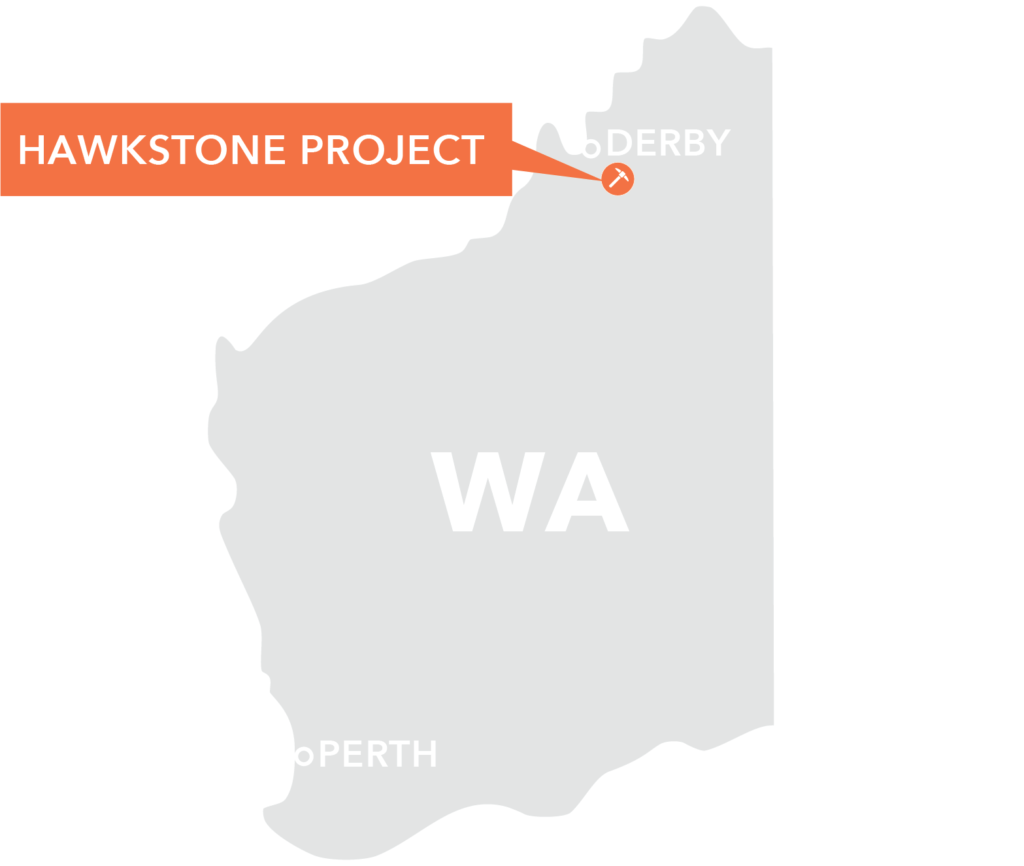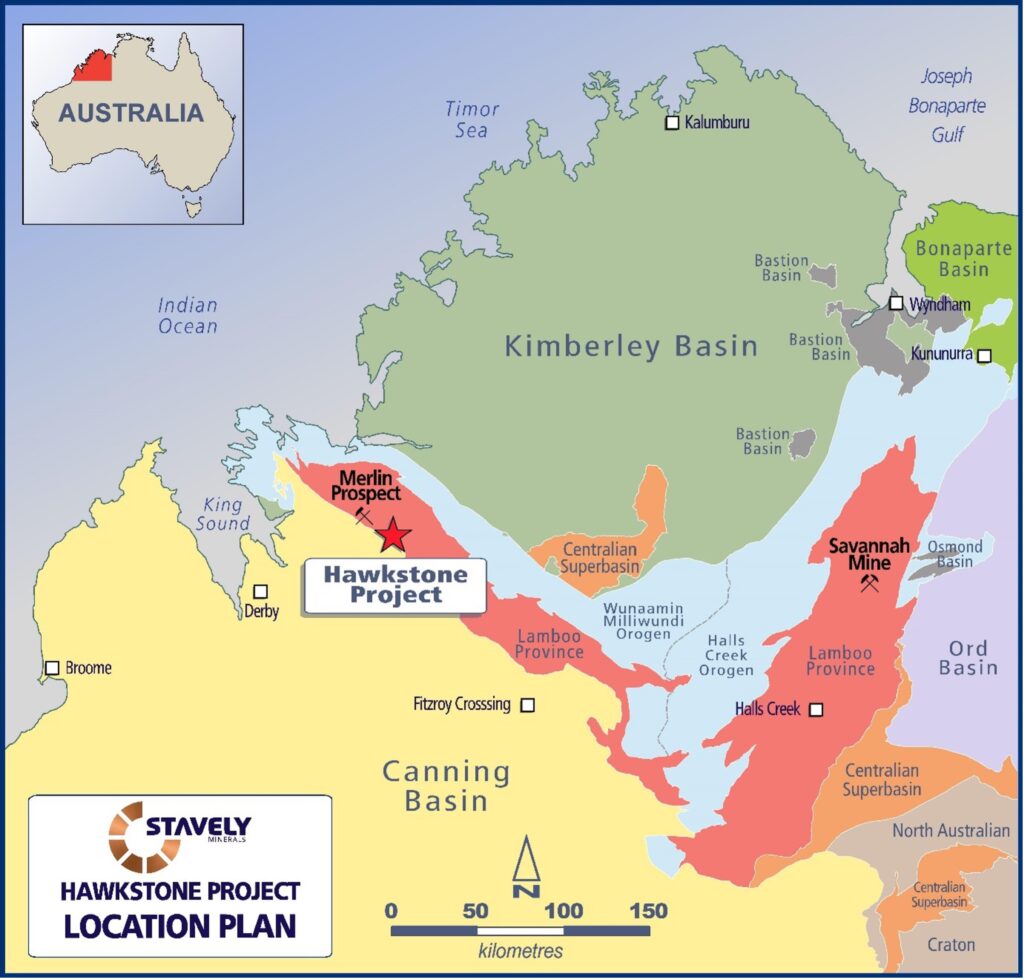
Hawkstone Project
~1000KM2 | NICKEL-COPPER EXPLORATION

PROJECT OVERVIEW
The Hawkstone Project covers an area of approximately 1,000 square kilometres over highly prospective stratigraphy in the west Kimberley, in northern Western Australia. The Company is targeting Nova-style magmatic Ni-Cu sulphide mineralization, similar to that intersected at the Merlin and very recent Dogleg discoveries on the adjacent tenement held by Buxton Resources/IGO. The high-grade massive nickel sulphide mineralisation at Merlin and Dogleg are hosted in the Ruins Dolerite and located 1km and 13km respectively, along strike to the northwest of the Hawkstone Project.
QUICK LINKS
HAWKSTONE PROJECT
The Hawkstone Project covers an area of approximately 1,000 square kilometres over highly prospective stratigraphy in the west Kimberley, in northern Western Australia. The project includes four 100% owned granted tenements, E04/2299, E04/2325, E04/2784 and E04/2871. Five granted tenements with 100% ownership of the hard-rock mineral rights, E04/1169, E04/2563, E24/2405, E04/2717 and E04/2623 as well as three 100% owned tenement applications, EL04/2872, E04/2877 and E04/2878.
In addition Stavely Minerals have signed an Earn-in and Joint venture agreement with Falcon Metals Limited over two tenement applications, E04/2883 and E04/2884.
The granted tenements cover an area of 828 square kilometres and the tenement applications cover 338 square kilometres.
The Kimberley is a vast area that has been massively under-explored largely due to the remoteness of the region and the associated cost of doing exploration. There is a lack of previous exploration over the project area since the 1970’s and hence has not been explored using modern techniques.
Stavely Minerals Limited is targeting Nova-style magmatic Ni-Cu sulphide mineralisation in the Hawkstone Project which is located in the Proterozoic belts of the west Kimberley region.
There has been a renewed interest in the west Kimberley for nickel exploration since drilling of the Ruins Dolerite resulted in the discovery of high-grade massive nickel sulphide at the Merlin Prospect, about 1km to the north west of the Hawkstone Project in 2015 by Buxton Resources. The Merlin Prospect and the very recently discovered massive nickel sulphide at the Dogleg Prospect are located in the Double Magic and Quick Shears joint venture between Buxton Resources and IGO. Of economic note is the average high nickel tenor at the Merlin Prospect, which was calculated to be 8% in 2018 based on the drilling up to that time.
The opportunity to drill nickel sulphides like that intersected at Merlin and Dogleg Prospects to the northwest of the Hawkstone Project is compelling. The Hawkstone Project is directly along strike 1km from known mineralisation and lies along the same gravity ridge.
In 2023 the Company completed a detailed airborne gravity gradiometer survey over the Hawkstone Project. The previously available gravity survey over the project was of poor resolution (GSWA regional survey with ~400m grid cell size). IGO/Buxton have found that conducting detailed gravity shows very high resolution of the Ruins Dolerite stratigraphy and is useful in defining specific prospective units. IGO/Buxton noted that all the EM conductors associated with sulphides are also associated with gravity highs.
The target mineralisation consists of primary orthomagmatic intrusion related Ni-Cu-Co sulphides within magmatically differentiation and layered mafic- ultramafic intrusive igneous sills of the host Ruins Dolerite. The Hawkstone Project is also highly prospective for pegmatite-associated lithium mineralisation, with a number of historic tin-tungsten-tantalum mines/occurrences in the area indicative of potentially lithium-prospective pegmatites derived from the highly fractionated Mondooma and Lennard Granites.

REGIONAL GEOLOGY
The Hawkstone Project is located within Marboo Formation turbidite sediments and is intruded by Ruins Dolerite and Paperback Suite granite and gabbroic intrusions. These rocks comprise the western Kimberley Proterozoic orogen which forms a series of west dipping faulted blocks against the Archean Kimberley Craton. The area has been subjected to four orogenies.
- the 1870–1850 Ma Hooper Orogeny
- the 1835–1810 Ma Halls Creek Orogeny
- the <1000–800 Ma Yampi Orogeny
- the c. 560 Ma King Leopold Orogeny
The oldest rocks exposed in the Orogen are metamorphosed sedimentary rocks of the Marboo Formation deposited 1872 Ma and their high-grade equivalents. The upper and lower boundaries of the Marboo Formation are marked by sills of the intruding Ruins Dolerite. The 1870–1850 Ma Hooper Orogeny involved voluminous magmatism, representing partial melting of Paleoproterozoic to Archean rocks, that includes the co-genetic 1865–1850 Ma Paperbark Supersuite granites and the c. 1855 Ma Whitewater Volcanics ignimbrites. These units intrude and unconformably overlie the Marboo Formation and Ruins Dolerite.
